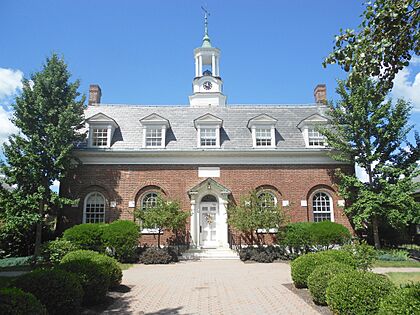Waverly, Pennsylvania facts for kids
Quick facts for kids
Waverly, Pennsylvania
|
|
|---|---|
| Country | United States |
| State | Pennsylvania |
| County | Lackawanna |
| Township | Waverly |
| Area | |
| • Total | 1.57 sq mi (4.06 km2) |
| • Land | 1.57 sq mi (4.06 km2) |
| • Water | 0 sq mi (0.0 km2) |
| Elevation | 1,280 ft (390 m) |
| Population
(2024)
|
|
| • Total | 516 |
| • Density | 386/sq mi (148.9/km2) |
| Time zone | UTC-5 (Eastern (EST)) |
| • Summer (DST) | UTC-4 (EDT) |
| ZIP code |
18411, 18414, 18471
|
| FIPS code | 42-81664 |
| GNIS feature ID | 2630046 |
Waverly is a small community in Lackawanna County, Pennsylvania, United States. It's a special kind of place called a "census-designated place" (CDP), which means it's a community that the government counts separately for population data.
Waverly was first settled in the late 1700s by people from Connecticut. Back then, it was known as Abington Center. The community was built along an old trail called the Warriors' Path. In 2024, about 516 people lived in Waverly.
Contents
Exploring Waverly's Location
Waverly is located in the northwestern part of Lackawanna County. It sits in the north-central area of Waverly Township. Nearby towns include Dalton to the northwest and Clarks Green to the south. The big city of Scranton is about 9 miles (14 km) south of Waverly.
Two main roads, Pennsylvania Route 632 and Pennsylvania Route 407, cross paths right in the center of Waverly. These roads help people travel to and from the community.
The land area of Waverly is about 4.1 square kilometers (1.6 square miles). A small amount of this area is water, mostly from streams like Ackerly Creek. These streams eventually flow into the Susquehanna River.
A Look Back at Waverly's History
The very first settlers built simple cabins in Waverly around the year 1800. A major road, the Philadelphia and Great Bend Turnpike, was built between 1820 and 1824. This road helped the town grow. Soon, the first non-cabin houses appeared.
In 1828, the Wayside Inn was built, and the town got its first doctor, Andrew Bedford. A general store opened in 1830, followed by another inn. From 1847 to 1890, Waverly became a busy industrial center. Factories that worked with iron were common, and many shops thrived, selling everything from groceries to hardware. Farmers also sent their goods to New York City.
However, when the railroad was built west of Waverly in 1880, the town's industrial success began to slow down.
Waverly and the Underground Railroad
In the mid-1800s, Waverly played a role in the Underground Railroad. This was a secret network that helped enslaved people escape to freedom. People in Waverly were friendly to those seeking freedom, and some even built small houses for them. These freed people also built the AME Church, which is still standing today as a private home. In 1872, Waverly had five churches, and three of them are still active congregations.
Learning in Waverly
Education has a long history in Waverly. The first school started in a log cabin in 1804. A dedicated school building was put up in 1830.
In 1844, a special private school called the Madison Academy opened. It was highly respected and taught both boys and girls a challenging curriculum. Students came from all over Pennsylvania to attend. Many graduates became important figures like judges and lawyers. The cost was low, ranging from $2.00 to $10.00 per quarter.
The Madison Academy closed in 1878, but the building was used as a public school until 1925. Later, the Belin family gave money for a new school building. Today, the Waverly Elementary school is on that site, serving students from kindergarten to fourth grade. It is part of the Abington Heights School District.
A bell from the old Madison Academy still hangs behind Waverly Elementary. It reminds everyone of Waverly's long tradition of great education.
The Great Fire of 1916
In the spring of 1916, a big fire destroyed four blocks of downtown Waverly. Only 11 businesses were left. The burned-out area was not very pretty, even though summer visitors still came to Waverly from Scranton.
The wealthy Belin family bought the damaged land. They planned and built the Waverly Community House. This beautiful building was finished in 1920. It transformed the downtown area into a lovely community center.
The Waverly Community House, often called "The Comm," is at the heart of Waverly. This brick building is home to the Waverly Post Office, a gym with a basketball court, and a public playground. It also has a preschool and offers many fun activities for families. The Comm hosts events like a home and garden show, antique fairs, and outdoor concerts.
Margaretta E. Belin paid for the Community House to honor her husband, Henry Belin Jr., after he passed away in 1917. In 1920, the building was given to Abington Township for everyone in the area to enjoy. Many wealthy summer visitors from Scranton decided to move to Waverly permanently. This helped Waverly become known as a nice place for people who work in offices to live.
Famous People from Waverly
- Bill Scranton: He was the governor of Pennsylvania from 1963 to 1967.
- Mary Scranton: She was the First Lady of Pennsylvania during her husband's time as governor.
See also
 In Spanish: Waverly (Pensilvania) para niños
In Spanish: Waverly (Pensilvania) para niños




